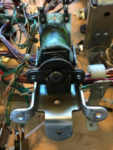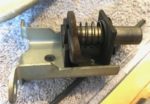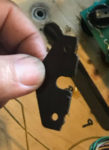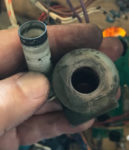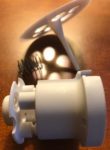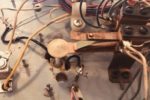
A. Parts
B. Tools & Supplies
C. Removal Below
1. Lamp Socket
D. Removal Above
E. Inspect Playfield
F. Cleaning
G. Rebuilding the Mechanism
1. Solenoid
2. Switch
H. Reinstallation
1. Upper Parts
2. Switch Adjustment
3. The Solenoid
The pop bumpers (also known as jet bumpers or thumper bumpers) get a workout during game play. And a game with poorly working pop bumpers is not nearly as much fun as one where the pop bumpers are sensitive and powerful.
Thankfully, while there are several steps, it is not too difficult to overhaul the pop bumpers and get them to work like new. Don’t let the length of this page discourage you from accomplishing this task.
Note: Click on most images for a larger photo.
The Parts of the Pop Bumper
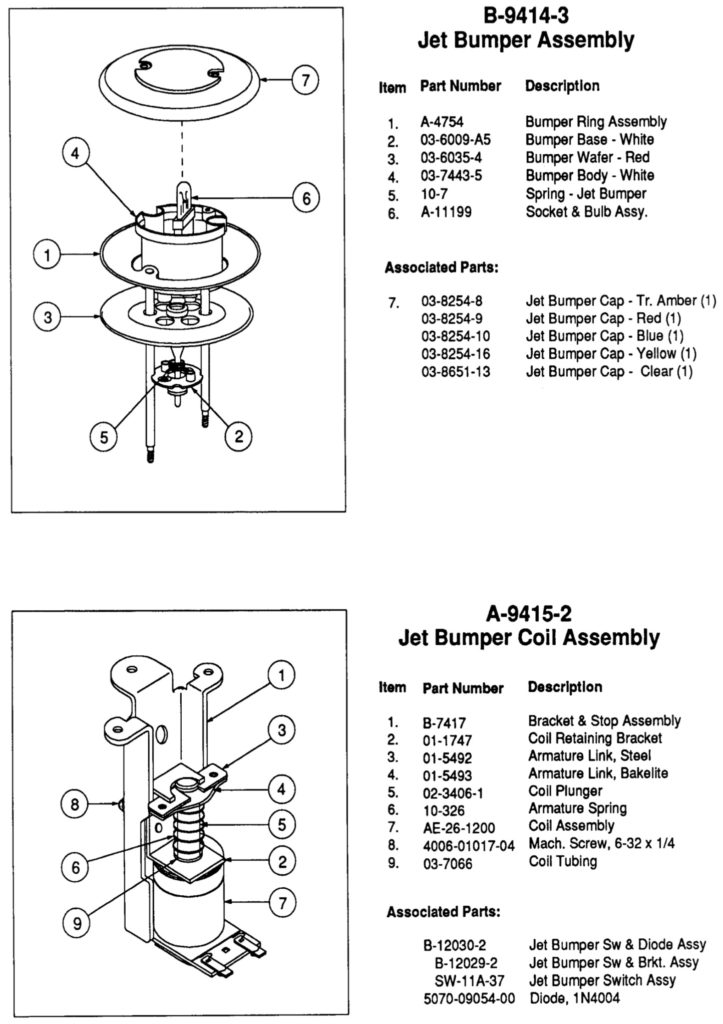
In the accompanying photo, the parts in the top photo are above the play field.
The parts below the playfield are in the lower photo.
The pop (or jet) bumper on all pinball machines are essentially the same. The main interior body (4 – top picture) is attached to the playfield by two wood screws (not shown). The bottom bracket (1 – bottom picture) is held attached to three mounting twist screws that sit flush to the playfield (not shown).
There are two moving parts above the playfield:
*The ‘Bumper Wafer’ (3) or ‘skirt’ moves when a pinball hits it and activates the switch (not shown) below the playfield.
*The metal ‘bumper ring assembly’ (1) is pulled down by the solenoid and ‘pops’ the pinball.
There is just one moving part below the playfield:
*The coil plunger (5) is pulled down into the coil (7) when the coil is activated. The metal ‘bumper ring assembly’ from above the playfield is connected to the plunger at the two screw holes shown in the photo.
Tools & Supplies
Required
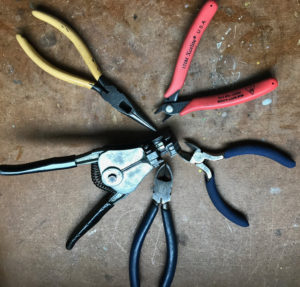 Pinball Switch Adjustment Tool – A must have.
Pinball Switch Adjustment Tool – A must have.
Plastic spoon – We always replace this. It can make all the difference.
Pop Bumper Skirt – These can be cleaned and reused. But they are inexpensive, new ones look great, and if the tip that touches the switch is worn, all your work will be for naught.
Pop Bumper Fiber Yoke – These vary a little bit between machines. Williams and Bally use one type, while Data East / Sega / Stern use another. These can be broken or worn. These are cheap – just replace them.
Pop Bumper Metal Yoke – These can be broken and you might not be able to tell until you take it apart. Williams and Bally use one type, while Data East / Sega / Stern use another. Keep some on hand.
Soldering Iron and Solder– To solder / unsolder the lamp wire connections. See suggestions on the linked page.
Pop Bumper Coil Sleeve – This can be cleaned and reused in most cases, but it is cheap – replace it. Most use 1 & 3/4″ but check your part number list.
Nut Driver Set – Generally, English sizes as metric was not commonly used (until recently?).
Screw Drivers – Usually Phillips.
Needle-Nose Pliers – Have to have these.
Wire Cutters – Usually small.
Suggested

Pop Bumper Cap – These can usually be reused, but if worn, try to replace it. Custom ones can be difficult to find. Check The Pinball Resource for the most complete supplies of custom caps.
Pop Bumper Bracket Mounting Screws (Twist Screws) – There are three on each pop bumper. Check to see if any on your playfield are broken off. If so, replace them.
Pop Bumper Body – Usually the existing one can be reused if not broken. There are many different types.
Pop Bumper Springs – These can normally be reused. There are two of them, a fine one that holds the skirt off the switch, and a heavier one that holds the plunger above the solenoid coil. The fine one is the most important. They are cheap and easy to replace. Check the part numbers in your manual.
Voltmeter (DVM) – The single most useful tool.

Pop Bumper Lamp Socket – If your pop bumpers contain the #44 bayonet sockets, they are lousy. Replace them with wedge sockets. Flat wire leads fit the best. Insulated wire leads are easier to install but the bulbs sit higher and may hit the cap. We have started using the socket with the centering bracket.
Socket Wrench Set – Generally 1/4″ and 3/8″ drives.
Magnet Pickup Tool – The day you drop a small screw or nut, you will wish you had this.
Parts Organizers – We use old muffin tins for the small parts, and larger plastic tubs for other parts. Some use zip lock bags. Something to organize the parts is a requirement.
Magnetic Cup – Great to hold a few parts.
Dremel – Battery operated is more convenient.
Dremel Tools – Get the variety pack. We always seem to be reaching for something. Conical stone sander, Sanding brushes, among others are useful.
Rotisserie – We use one every time. A simple one is inexpensive, quick to make and stores easily.
Light Stand – Additional light source.
Supply of Stranded Wire – Handy to have if replacing sections of wire. Heavier gauge maybe needed too.
Wire Strippers – While a wire cutter can do in a pinch, it usually nicks the wire and weakens it.
Shrink Tubing – Buy a kit and keep it handy. Use to keep wires insulated.
Wood Screws – Replacement wood screws that hold in the pop bumper body. Available from your local hardware store.
Wood Glue – Used for repair of the more severely damaged screw holes.
Wood Toothpicks – We insert those in almost every wood screw hole to tighten the hold.
Mean Green – or similar cleaner. Used for soaking the plastic parts.
Pop Bumper Bracket and Coil Stop – These only need to be replaced if broken.
Removal of the Parts Below the Playfield
This is the easy part! The first step is to remove the two nuts (photo 2) holding the metal ring which is connected from the solenoid to the parts above. Set these two nuts in your storage container.
If you have taken off the Pop Bumper Cap above the playfield, it should be possible to remove the ring assembly by lifting it up above the playfield. Set this metal ring aside. Repeat for the other rings.
Next, remove the three nuts holding the bracket in place (pictures 3 & 4). Set those nuts aside. The entire lower Pop Bumper Assembly should be loose. Remove this from the three screws.
It is possible to leave this assembly hanging from the two wires going to the coil. However, we usually use a zip tie to attach it to the nearby wiring harness. It maybe easier to unsolder these wires. If you do and there is a diode on the coil, note which wire goes to which lug.
Removal of the Lamp Socket
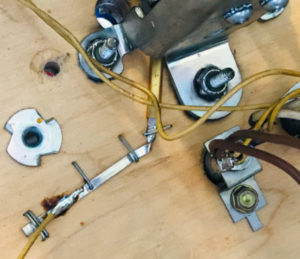
The most annoying part of working on the pop bumpers is removal of the lamp socket. This only has to be done if removing the above playfield portion.
Inconveniently, the lamp socket is a wire an uninsulated flat wire ribbon. It is usually held in place by staples and has wires soldered to it. This has to be carefully removed.
Take photos of each wire connected to the flat wire ribbon. Be sure to get a photo of the color of the wire. Use a piece of masking tape and label the wire. Then unsolder the wires and set them aside. We sometimes outline the position of the lamp wires on the playfield so we can reposition them in the exact same location.

Unless you have a pneumatic stapler handy, you will not be able to replace the staples. Most of the time, we lightly pry up or bend the center of the staple, so that the wire ribbon can be slid out. Remove as much as possible of the solder remaining on the wire, otherwise it will not pull through the pop bumper body.
Work the ribbons free from the staples. If there is a clear insulator, remove that. Save this insulation although we usually replace it with shrink tubing.
The lamp socket can be removed now, but we usually remove it with the upper body of the pop bumper.
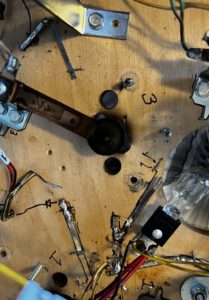
An easier alternative is to just cut the metal ribbon and then plan on replacing it with a new socket. This makes a lot of sense if it currently has a bayonet (round base) bulb socket as they lose the ‘spring’ and oxidize. But the 555 wedge sockets last almost forever. But these are ~40 year old sockets. We just cut the ribbon, and then pull the bulb socket through the base and replace.
Those bulb sockets with insulated wires are easier to deal with than the metal uninsulated ribbon wires anyway.
Removal of the Above Playfield Pop Bumper Parts
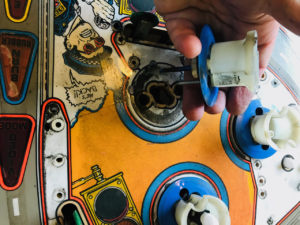 The rest of the removal process is easy. If you have not already removed the pop bumper cap, do so now. Remove the lightbulb.
The rest of the removal process is easy. If you have not already removed the pop bumper cap, do so now. Remove the lightbulb.
The entire upper structure is held in place by two wood screws on either side of the lamp socket. Loosen those all the way. It is not necessary to remove the screws.
Carefully lift the upper assembly. There are two things still holding it in place: 1) the lamp socket ribbon working its way through the loosened staples, and 2) sometimes the upper body fits snugly in the playfield hole.
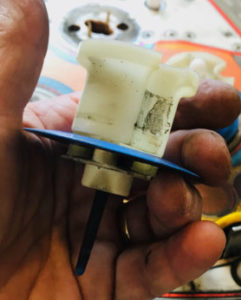 Give a pull to break it free. It should not require much effort. If it does not move easily, check your work.
Give a pull to break it free. It should not require much effort. If it does not move easily, check your work.
Once free, remove the assembly while guiding the pop bumper socket through the staples.
Don’t take this assembly apart just yet. Press down on the bumper wafer (skirt) on any side. Notice how the point in the bottom moves, then springs back up. It is crucial that this be re-assembled so it works this way.
Set this assembly aside. Be certain to remove the two flathead wood screws inside the body and place them in your storage container.
Also remove the lamp socket from the pop bumper body. If this does not pull through the holes in the bumper body, you will need to remove solder from the ribbon. If not reusing this, you can cut off the ribbon wires at the bottom and pull the remaining lamp socket out.
This assembly will pop apart easily. If you do so, be sure to save the spring in the interior, if you plan on reusing it. There will be three parts (numbers refer to the first photo): 4) the main pop bumper body, 3) bumper wafer (skirt) – the part the pinball touches to activate the switch below, 2) the bumper base, and 5) the spring – and perhaps the lamp socket. The numbers refer to the parts assembly above.
Inspect the Playfield

There are a few things to take note at this point. First, notice how much dirt was underneath the assembly. Clean this up.
But more important, inspect the condition of the wood screw holes. Those in this picture show the condition of screw holes that were stripped. These are the two smallest ones on either side of the larger center hole. These will have to be repaired.
If not too badly damaged, the screw hole can be ‘healed’ by inserting a toothpick. A bit larger, and it may take more than one toothpick and some wood glue to hold it together.
Cases like the upper left one requires more extreme measures. Some people will drill it out to fit a small wooden dowel with glue. That is the most effective, but usually not required. We have used wood putty, but that does not drill and screw very well – but it can be done. Otherwise, it might be OK to use a mixture of wood glue and sawdust (and toothpicks if needed). We mention this now because these methods can require planning, plus the glue should set before reassembly occurs.
Cleaning the Plastic Parts and Metal Ring
 Clean up any plastic parts that you plan on reusing. These are the parts above the playfield. That includes the main body (4 in image), cap (7) and skirt (3). Soak these plastic parts overnight in a container of diluted Mean Green or similar cleaner. Note: If the pop bumper cap has painted artwork, do not soak that in cleaner as it will remove the artwork. We highly recommend replacing the pop bumper skirt.
Clean up any plastic parts that you plan on reusing. These are the parts above the playfield. That includes the main body (4 in image), cap (7) and skirt (3). Soak these plastic parts overnight in a container of diluted Mean Green or similar cleaner. Note: If the pop bumper cap has painted artwork, do not soak that in cleaner as it will remove the artwork. We highly recommend replacing the pop bumper skirt.
Clean up the ring assembly either by using a metal tumbler, or wiping with isopropyl alcohol. We also use fine sandpaper or a Dremel sandpaper brush on the part that contacts the pinball to make it look like new.
Rebuilding the Pop Bumper
Rebuilding the Pop Bumper Solenoid
There is some variation in these parts, so your disassembly and reassembly might look like the parts in Image 1, or you may have a combination of parts like shown in Image 4 – disassembly and reassembly is similar and quite easy if done methodically.
Note the orientation of the wires on the coil. If you have unsoldered these wires and there is a diode, be sure to reattach the same one to each tab or you will blow a fuse – a backwards diode is a direct short. If there is not a diode on the coil, then the positions of the wires does not matter.
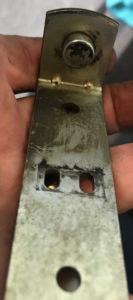
To disassemble, remove the two screws (part 8 in image 1) on the side that that hold the center coil retaining bracket (part 2 in image 1) in place. It will then be possible to remove the coil and plunger from the bracket.
As the plunger comes out, there are four parts – don’t let them fall apart. These are a metal plate (part 3), bakelite plate (4), spring (6) and plunger (5). Note the way these come apart as that is how you will have to put them back together. Of those parts, the bakelite plate is the most likely to be damaged (image 5 is light damage). Replace it if required (new and old are in image 6). If not damaged, clean all of these parts with a rag and isopropyl alcohol. For a thorough shop job, replace the metal plate, bakelite plate and spring.
Clean the pop bumper bracket with the rag and isopropyl alcohol. Replace (or clean) the coil sleeve (image 7). Prior to replacing the sleeve, clean out the interior of the coil. Coils do not wear out. They will work nearly forever. Replacing a coil will not make the pop bumper stronger.
Inspect the diode (if present). Test it by inserting a screwdriver between it and the pop bumper, then lightly pry on it. If it is broken, it will pop off and will need to be replaced in the same orientation as original. Note that later games do not have a diode and most EMs do not either.
Inspect the wires. If the strands are broken, unsolder the wire, cut off the end, strip it and solder.
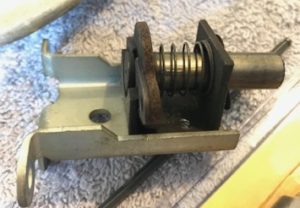
Reassemble the pop bumper. Note that the metal plate is on top and oriented towards the inside of the bracket, while the fiber or bakelite is underneath the metal plate and facing out (like it was in image 4), along with the spring. These fit inside the two sections of the coil retaining bracket (2). Insert this into the coil and onto the bracket stop. Attach the bracket onto the main bracket using the two screws. Getting this back together might require a little practice to get everything oriented and together properly. Make certain the wire tabs on the coil are facing in the direction they were originally.

Test the pop bumper plunger by pressing it down to insure that it moves smoothly and pops back up freely.
The lower pop bumper assembly has been rebuilt.
The final assembly of the pop bumper solenoid and switch has to be completed after the pop bumper parts above the playfield are re-installed.
Rebuilding the Pop Bumper Switch
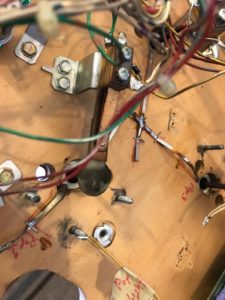
Having lively pop bumpers is one of the more important parts of the game. The key is making certain that the switches are rebuilt, cleaned and correctly adjusted. Prior to adjusting the pop bumper switches, make certain that they are clean and working properly.
Perhaps the most overlooked part of the pop bumper switch is the plastic pop bumper spoon. Most people clean it and move on. But this part wears out. A divot can form where the pop bumper skirt touches the spoon. This divot can be tiny, but it makes it harder for the skirt to be moved by the pinball. Replace the pop bumper spoon.
Remove the two wood screws holding the switch assembly to the playfield. Remove the two nuts holding the switch to the bracket, and lift off the spoon.
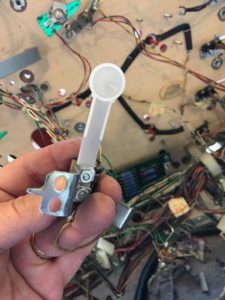
While the spoon is off is the easiest time to see and clean the switch contacts so they are nice and bright.
Clean the switch contacts with isopropyl alcohol and a Q-tip. That will remove some of the deposits, but it maybe necessary to wipe it clean. Many people put a business card between the contacts, press the switch contacts together and pull the card through several times.
For all SS games, these are gold contacts and must never be filed. EM pins have higher current switches. If they are tungsten, they could be filed. We like using a Dremel 443 brush on the contacts as it is less destructive.
Be sure to set the new spoon with the ‘cup’ side towards you as shown in the photo. Replace the bracket so that it faces the same direction and tighten the screws and nuts.
While tightening, the ‘sandwich’ of switch leafs and the spoon can twist or slide. Make certain they are all aligned together and perfectly centered.
Note that early SS pinball machines may have a capacitor (Bally / Stern) or a capacitor and resistor (Williams). These must be in place for the relatively slow computer to work. Check to insure that the leads are soldered and they are not broken. Place a DVM across the capacitor and insure that it is not shorted.
Reinstallation
Upper Playfield Parts
It is far easier to install the parts above the playfield, first, mostly because of routing the lamp socket wires.
Assembly
Four parts need to be put together, in the proper orientation for this to work: pop bumper skirt, small spring, bumper body, and bumper base. The lamp socket will be installed later. Refer to the ‘Pop Bumper Parts’ photo for the following steps.
1) Insert the small spring into the bumper base(2). While holding the spring in place,
2) Insert the skirt (3) with the long center point, through the spring and base. While holding that in place,
3) Insert the white popper body (4) through the skirt and into the base.
If everything is oriented properly, the body will be held, by friction, snugly to the base, with the spring and skirt in between them. The outer holes in the skirt will be aligned with the indentation in the body, so that the metal ring can fit down in place (last photo). The skirt should be pushed up by the spring, but be easily pushed down on any side – check this.
This may take some practice to get it right.
After everything is together, install the lamp socket into the assembled upper body as shown in the 4th photo.
Installing the Upper Pop Bumper body

The upper pop bumper body is attached to the playfield with two flat head wood screws. Inspect the holes first. In most cases we put a toothpick into the hole to make the screws hold. For wood holes see ‘Wood Screw Holes’, above.
Install the upper pop bumper assembly with the two wood screws. We then use a black Sharpie to darken the tip of the skirt that sits in the switch spoon to aid in adjustments.
Once the upper body is installed, the wires for the pop bumper lamps must be routed, stapled and soldered into place. This is easier to do now than when the pop bumper solenoids / coils have been reinstalled. We install shrink tubing over the bare wires to prevent shorts. There is always one wire that routes between the screws and will be located close to the pop bumper bracket. That must be insulated. The other wires are optional.
 We find that we need to use a pneumatic stapler. Manual nor electric staplers seem to penetrate the wood. However, if when you removed the wires, you just raised the staples slightly and left them in place, they should be sufficient to hold the wires. Tap them back down lightly if desired.
We find that we need to use a pneumatic stapler. Manual nor electric staplers seem to penetrate the wood. However, if when you removed the wires, you just raised the staples slightly and left them in place, they should be sufficient to hold the wires. Tap them back down lightly if desired.
If everything is aligned properly, the metal pop bumper ring will be able to slide over this assembly with the two rods going through the holes (see ‘notch’ photo above) and into the playfield below. Install the pop bumper cap to keep the metal ring from falling back out. The cap is usually held in place by two small screws. Do not over tighten or the cap may break.
Adjusting the Pop Bumper Switch
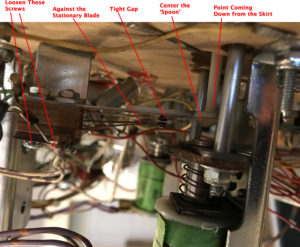
This adjustment can only be done properly, after the pop bumper parts above the playfield have been reinstalled.
For details on adjusting and positioning the pop bumper switch, please see our section on adjusting switches. Also be certain to read the section on leaf switches. Reading and understanding the proper way to adjust these leafs is crucial to having a sensitive pop bumper.
Prior to the final adjustments of the switch, it is crucial to center the tip of the skirt into the spoon. If it is not centered, then the pop bumper will be far more sensitive on one side of the pop than the other.
There are two sets of screws on the switch that are useful in centering the spoon in the tip of the skirt. The first ones to use are the two screws holding the switch bracket to the playfield. Loosen those just a little, then move the switch from side to side and front to back to center the tip in the spoon. A blackened skirt tip will make that a little easier to see.
If centered, tighten down those wood screws. If you are unable to center the spoon, it will be necessary to loosen the two screws holding the switch stack to the bracket. While adjusting that switch stack it is easy to get those leafs and spoon out of alignment with each other, so be careful.
Carefully adjust the leaf switch as outlined in the section on It is important that the stationary blade hold the flexible blade in position. the upper blade needs to be fairly hard against the spoon. That will prevent bouncing of the switch. Adjust that gap to be very tight. Too far apart and you will have an insensitive pop bumper. Too close and you will get false pops.
Note that some pop bumpers will have two sets of switches. The one set closer to the playfield needs to be set tightly together as described above – that activates the pop bumper. The one further away activates the scoring and sounds. That one is closed when the pop bumper activates and adjustment is just so it closes when the solenoid drawn in.
When the pop bumper is not activated, this upper switch must be open. When the solenoid pulls in, this switch must close.
Installing the Pop Bumper Solenoid (Below the Playfield)
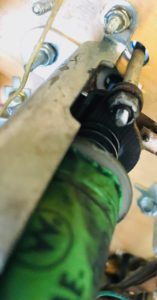
The ring assembly (1) should already be installed. If not, install it now.
Below the playfield, first install two washers onto the rods of the ring, then grab your rebuilt pop bumper solenoid & bracket, slide it onto the three screws on the bottom of the playfield and simultaneously work these rods into the two holes of the pop bumper solenoid and the metal and wafer yokes. Install the two nuts to the ring and the three nuts holding the pop bumper bracket in place, and tighten.
If you removed the wires to the coil, solder them back now. If the pop bumper has a diode, then the wires have to go on in the proper location. Backwards is a short.
If your switch has two sets of switches, the one closest to the spoon is the one that activates the pop bumper. The lower one (furthest from the playfield) closes when the pop bumper activates. This second switch activates the CPU (SS pin) or a relay (EM pin) to score points and activate sounds. Both sets of switches must be between the playfield and the yoke – see photos in switch adjustment section.
Comments
Comments, including suggestions, improvements, errors, etc. are welcome (see below).
If you have a specific question about your game that does not directly apply to this page, please see our FAQ section.






